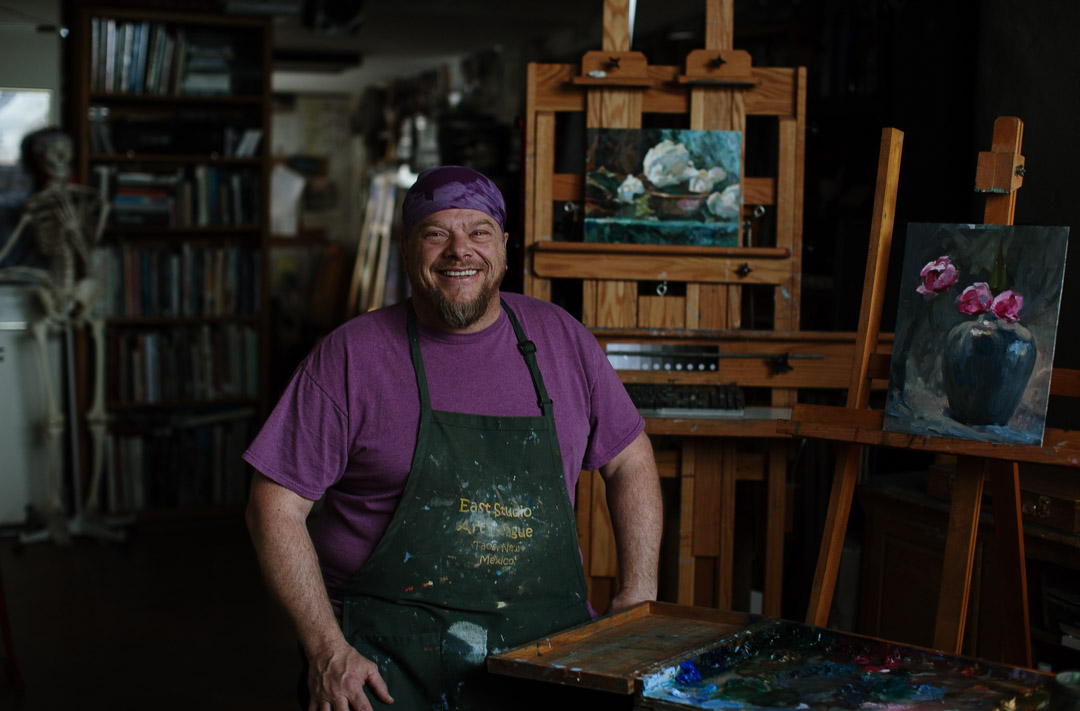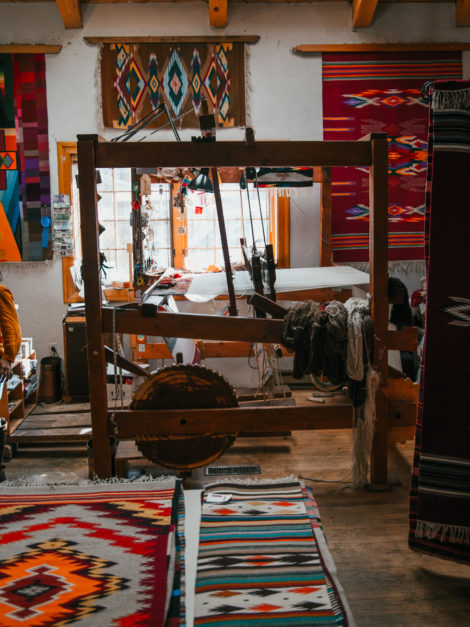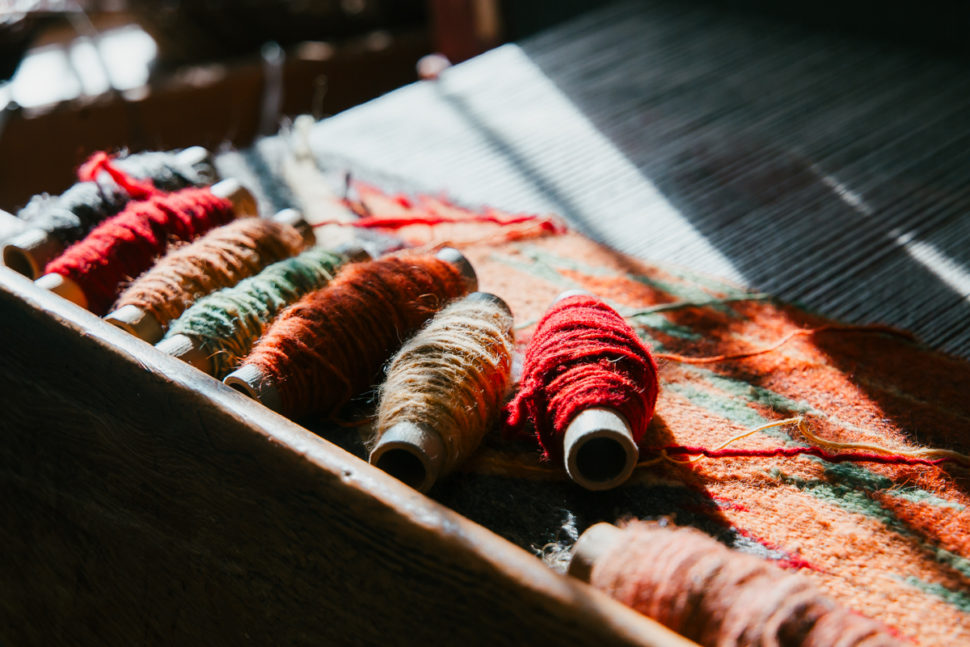New Mexico’s Northern Mountains Benefit from a Rich Cultural & Artistic Heritage
Northern New Mexico’s Early Cultural & Artistic History
The earliest New Mexico inhabitants, the ancestral Puebloans, left artifacts and petroglyphs throughout the region and these primitive artists created images and designs that represented their spiritual practices and relationship to their natural surroundings. Their earthen architecture used basic sustainable materials, proving long-lasting and resilient to the elements since you can still find some of their stacked adobe structures intact today.
In the early 1500s, the Spanish ventured North from their Mexico conquests in search of legendary cities of gold, and what they found were the Puebloan people and their ancient settlements. The Spaniards subsequently attempted to colonialize through the Catholic faith and around 1620, the first Pueblo Catholic church was built – the mission of San Geronimo de Taos.
 The early colonists learned to use local native materials and became imaginative skilled crafts folk who wove indigenous influences into their mostly religious iconography.
The early colonists learned to use local native materials and became imaginative skilled crafts folk who wove indigenous influences into their mostly religious iconography.
Unfortunately, tensions grew amongst the native peoples resulting in the Pueblo revolt of 1680, killing resident priests and continually destroying the San Geronimo de Taos church every time the Spaniards tried to rebuild. The regional Puebloan revolts were off and on through 1846, when American troops became involved and marched into Taos Pueblo and conquered the insurgency.
Blending Cultural Coexistence
The resulting détente started to pervade the area with the Puebloan earthy architectural sensibilities and the new European Spanish colonial Catholic iconography, thereby infusing a more elaborate and intricate construction ornamentation and artistic flare. This distinctive meld of Spanish and Indigenous artistic influences took hold and mountain villages became known for their natural Southwest styles.
Through Spanish imports of new materials, villages became centers of artistic specialties like tinwork, weaving, pottery, sculptures, paintings and silver work. Both Hispanic and Indigenous craftspeople took their goods to city centers where major art markets eventually developed.
Anglo Arrival Institutes Artistic Mecca
In 1898, Bert Phillips and Ernest L. Blumenschein (often referred to as Bert & Ernie) broke a wagon wheel North of Taos and found the surrounding landscape and community so overwhelmingly inspiring, that they abandoned their journey, promptly forgot about their planned itinerary and stayed on. Soon, many notable Anglo artisans descended on the region for the exotic Southwestern landscape and intersection of cultural elements. Word spread and the likes of Mabel Dodge Luhan, Gerogia O’Keeffe, Willa Cather, Millicent Rogers, Ansel Adams and D.H. Lawrence began visiting the region and thus instituted the area as an artistic hub.
The majestic landscape, magical ethereal light and cultural mélange has attracted all kinds of artists ever since.
Thus, what we have in the Northern New Mexico mountains are many artists who have maintained a rich connection to their village homes and plying their traditional family craftsmanship has been passed down generation to generation. Yet, you can also find them living in concert with artistic implants magnetized to this region for its artistic inspirations.
Heritage Inspirations Brings You to the Artistic Heritage
Heritage Inspirations revels in this artistic legacy of our mountain communities and works to develop honoring relationships with local artisans, representing our mixed culture. Small-town folk art lies hidden in the villages around us and we target artists that reflect this rich heritage.
In Taos, two places are favorites on our walking tour and are near and dear to our hearts. The Tres Estrellas gallery specializes in rare Southwestern textiles, with a focus on encompassing the three distinct cultures embodying New Mexico’s heritage. Within their space, you’ll find Navajo, Puebloan, and Hispanic Rio Grande collectibles spanning more than four centuries. While with Rich Nichols, you’ll get a contemporary impressionist painter allured to Taos in order to have the daily inspiration of “utopian vistas covered in silvery green and purplish tone.” To Nichols, Taos and his creativity are intimately intertwined. He felt a gravitational pull by the Taos Society of Artists’ story when studying at the Chicago Institute of Art, this group led by the early 1900s luminaries that created the artistic mecca, still resonates today for artists like Rich.
As you head up the High Road from Taos and into the Sangre de Cristos, you’ll quickly see why many craft their art exclusively in quiet beautiful mountain remoteness. Leigh Gusterson headed to New Mexico in 1990 in order to find the “freedom to express” herself. She paints colorful joyous landscapes representing her outdoor settings, with depictions of iconic Southwest elements like adobe buildings, churches and old trucks. And then there is Priscilla Walsen who makes contemporary stone inlay jewelry and is also regularly inspired by the colors, shapes, patterns and textures of the world around her. She uses those qualities to form unique three-dimensional handmade pieces.
Rey Montez helps to keep the world of Spanish Colonial and Christian art alive. Since 1989, he’s worked hard to amass the largest collection of contemporary and antique Spanish Colonial art in his bucolic gallery inside an adobe historic church. With four centuries of New Mexico family history behind him, Rey’s devotion to his heritage is evident throughout his gallery and he has been highly recognized for the preservation of this art form.
Toward the end of the High Road getting closer to Santa Fe’s prestige, is Chimayo. Here, you’ll also find long-term generational connections to specialty crafted art forms, centuries in the making. Irvin and Lisa Trujillo uphold a 400-year-old lineage of traditional Rio Grande weaving. Rio Grande weaving originates with Churro sheep, who were found to be a hardy breed for this dry environment and consequently their wool was used to create warm blankets to ward off cold mountain nights. Soon becoming the iconic Southwest look, with specific design elements, the Rio Grande blanket came under great demand. Their work has been showcased in the Smithsonian and they’re known for very traditional practices, like dying their own yarns, using a spinning wheel and loom, and maintaining traditional designs.
Then there is Chimayo’s artisan Sharon Candelario who has taken traditional tin work dating back to the 1800s and has given it new life. Using traditional canning tin, she blackens it and then etches it with a nail, creating one-of-a-kind devotional hand-crafted pieces.
Finally, there’s the legacy of Gabriel Ortega who settled into Chimayo in the early 1700s as a weaver. Over the generations his original weaving shop expanded into a general store, but thankfully the weaving stayed constant. Their family’s traditional hand-woven blankets and indigenous products have become cherished collector’s items and demonstrate historic authentic New Mexican roots.
All of these artists reveal the diversity of artistic styles, techniques and heritage that make New Mexico distinct. New Mexico has benefited greatly from artisans’ respect for old traditions, love for the mountainous landscapes, and the quiet contemplative splendor of the Southwest.
New Mexico is an iconic emblem of Southwestern culture because it is a unique mix of Native, Spanish and Anglo peoples, all of whom have found a way to share their love of art and integrate the communal influences of this land into their craft. This area is saturated with the people, the history and the heritage, highlighting how in this mountain region, everything is symbolic of New Mexico’s heritage and culture.
Tres Estrellas – Southwestern Textiles (Taos)
Rich Nichols – Contemporary Impressionist painter (Taos)
Leigh Gusterson – landscape painter (Penasco)
Priscilla Walsen – Silver Jewelry (Ojo Sarco)
Rey Montez – Spanish colonial gallery & Christian art (Truchas)
Centinela Traditional Arts (Irvin & Lisa Trujillo)
Sharon Candelario – Black Etched Tinwork (Chimayo)
Ortega’s – Weaving (Chimayo)
All images by Amanda Powell taken on our Taos Half Day Cultural Tour, The Magical Heirlooms of Chimayo Day Tour, High Road Artisan + Wine Tasting Tour, & Taos Artisan Walking Tour






2 thoughts on “New Mexico’s Northern Mountains Benefit from a Rich Cultural & Artistic Heritage”